Financial Decision-Making Report: Analysis of SKANSKA PLC Finances
VerifiedAdded on 2022/12/15
|12
|3834
|164
Report
AI Summary
This report provides a detailed analysis of financial decision-making, accounting, and finance within SKANSKA PLC, a UK-based construction company. The introduction emphasizes the importance of financial decisions for organizational growth and sustainability. The main body of the report is divided into two tasks. Task 1 explores the roles and responsibilities of the accounting and finance departments, highlighting their functions in financial management, tax, audit, and transaction recording. Task 2 focuses on ratio analysis, calculating and interpreting key financial ratios such as Return on Capital Employed, Net Profit Margin, Current Ratio, Average Receivable Days, and Average Payable Days for SKANSKA PLC to assess its financial performance and position. The report concludes with an overview of the findings and provides references for further study.

Financial
Decision-Making
Decision-Making
Paraphrase This Document
Need a fresh take? Get an instant paraphrase of this document with our AI Paraphraser
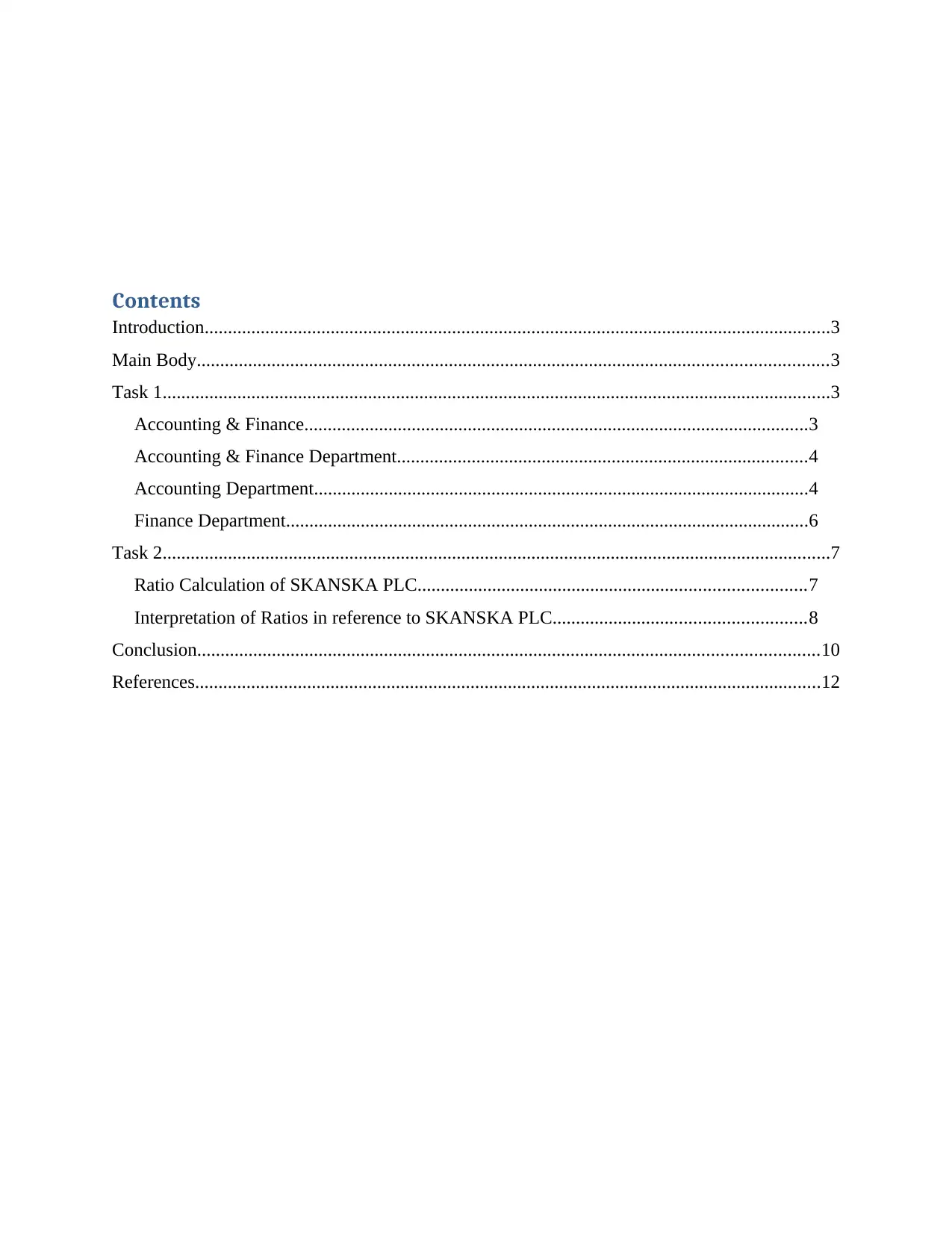
Contents
Introduction......................................................................................................................................3
Main Body.......................................................................................................................................3
Task 1...............................................................................................................................................3
Accounting & Finance............................................................................................................3
Accounting & Finance Department........................................................................................4
Accounting Department..........................................................................................................4
Finance Department................................................................................................................6
Task 2...............................................................................................................................................7
Ratio Calculation of SKANSKA PLC...................................................................................7
Interpretation of Ratios in reference to SKANSKA PLC......................................................8
Conclusion.....................................................................................................................................10
References......................................................................................................................................12
Introduction......................................................................................................................................3
Main Body.......................................................................................................................................3
Task 1...............................................................................................................................................3
Accounting & Finance............................................................................................................3
Accounting & Finance Department........................................................................................4
Accounting Department..........................................................................................................4
Finance Department................................................................................................................6
Task 2...............................................................................................................................................7
Ratio Calculation of SKANSKA PLC...................................................................................7
Interpretation of Ratios in reference to SKANSKA PLC......................................................8
Conclusion.....................................................................................................................................10
References......................................................................................................................................12
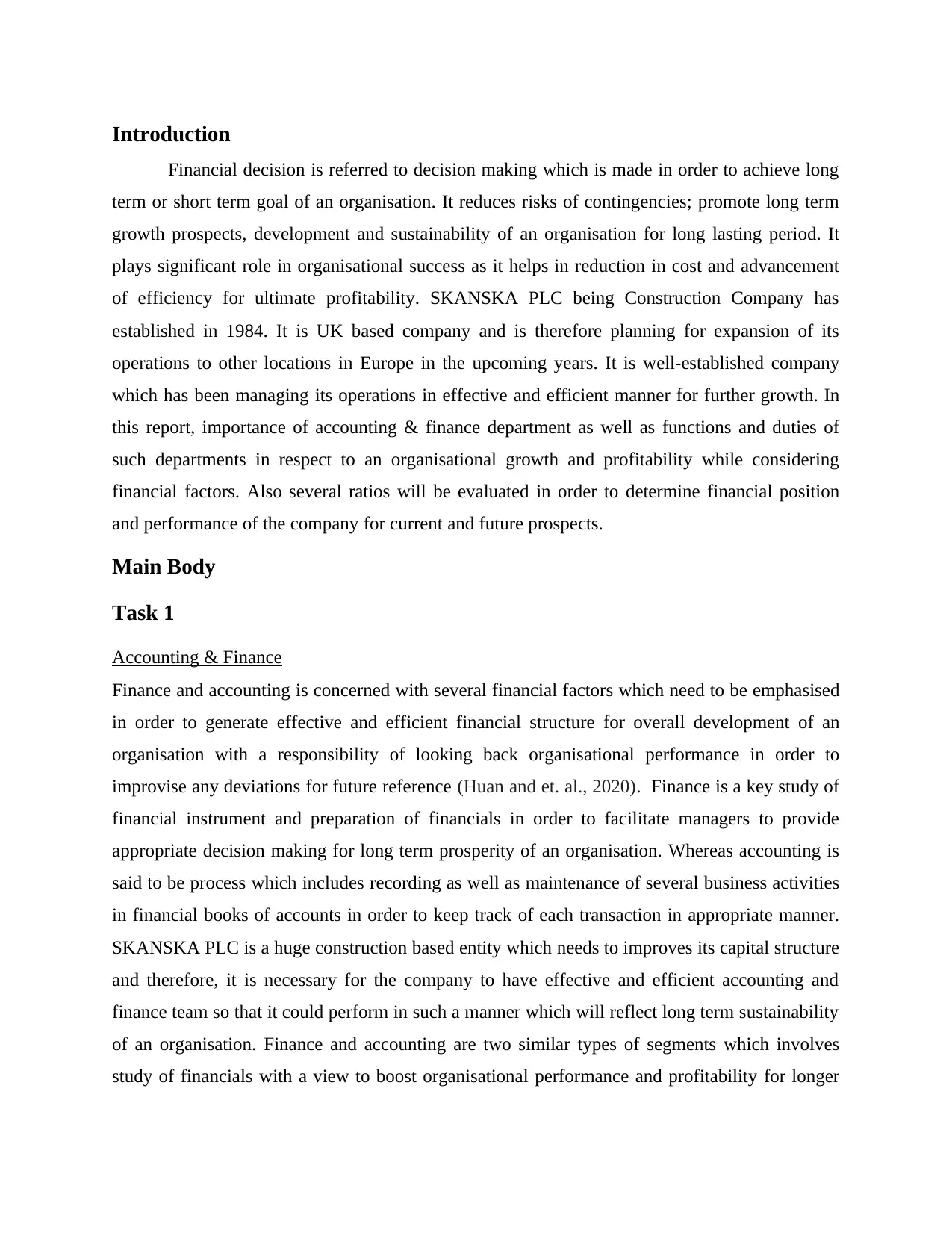
Introduction
Financial decision is referred to decision making which is made in order to achieve long
term or short term goal of an organisation. It reduces risks of contingencies; promote long term
growth prospects, development and sustainability of an organisation for long lasting period. It
plays significant role in organisational success as it helps in reduction in cost and advancement
of efficiency for ultimate profitability. SKANSKA PLC being Construction Company has
established in 1984. It is UK based company and is therefore planning for expansion of its
operations to other locations in Europe in the upcoming years. It is well-established company
which has been managing its operations in effective and efficient manner for further growth. In
this report, importance of accounting & finance department as well as functions and duties of
such departments in respect to an organisational growth and profitability while considering
financial factors. Also several ratios will be evaluated in order to determine financial position
and performance of the company for current and future prospects.
Main Body
Task 1
Accounting & Finance
Finance and accounting is concerned with several financial factors which need to be emphasised
in order to generate effective and efficient financial structure for overall development of an
organisation with a responsibility of looking back organisational performance in order to
improvise any deviations for future reference (Huan and et. al., 2020). Finance is a key study of
financial instrument and preparation of financials in order to facilitate managers to provide
appropriate decision making for long term prosperity of an organisation. Whereas accounting is
said to be process which includes recording as well as maintenance of several business activities
in financial books of accounts in order to keep track of each transaction in appropriate manner.
SKANSKA PLC is a huge construction based entity which needs to improves its capital structure
and therefore, it is necessary for the company to have effective and efficient accounting and
finance team so that it could perform in such a manner which will reflect long term sustainability
of an organisation. Finance and accounting are two similar types of segments which involves
study of financials with a view to boost organisational performance and profitability for longer
Financial decision is referred to decision making which is made in order to achieve long
term or short term goal of an organisation. It reduces risks of contingencies; promote long term
growth prospects, development and sustainability of an organisation for long lasting period. It
plays significant role in organisational success as it helps in reduction in cost and advancement
of efficiency for ultimate profitability. SKANSKA PLC being Construction Company has
established in 1984. It is UK based company and is therefore planning for expansion of its
operations to other locations in Europe in the upcoming years. It is well-established company
which has been managing its operations in effective and efficient manner for further growth. In
this report, importance of accounting & finance department as well as functions and duties of
such departments in respect to an organisational growth and profitability while considering
financial factors. Also several ratios will be evaluated in order to determine financial position
and performance of the company for current and future prospects.
Main Body
Task 1
Accounting & Finance
Finance and accounting is concerned with several financial factors which need to be emphasised
in order to generate effective and efficient financial structure for overall development of an
organisation with a responsibility of looking back organisational performance in order to
improvise any deviations for future reference (Huan and et. al., 2020). Finance is a key study of
financial instrument and preparation of financials in order to facilitate managers to provide
appropriate decision making for long term prosperity of an organisation. Whereas accounting is
said to be process which includes recording as well as maintenance of several business activities
in financial books of accounts in order to keep track of each transaction in appropriate manner.
SKANSKA PLC is a huge construction based entity which needs to improves its capital structure
and therefore, it is necessary for the company to have effective and efficient accounting and
finance team so that it could perform in such a manner which will reflect long term sustainability
of an organisation. Finance and accounting are two similar types of segments which involves
study of financials with a view to boost organisational performance and profitability for longer
⊘ This is a preview!⊘
Do you want full access?
Subscribe today to unlock all pages.

Trusted by 1+ million students worldwide
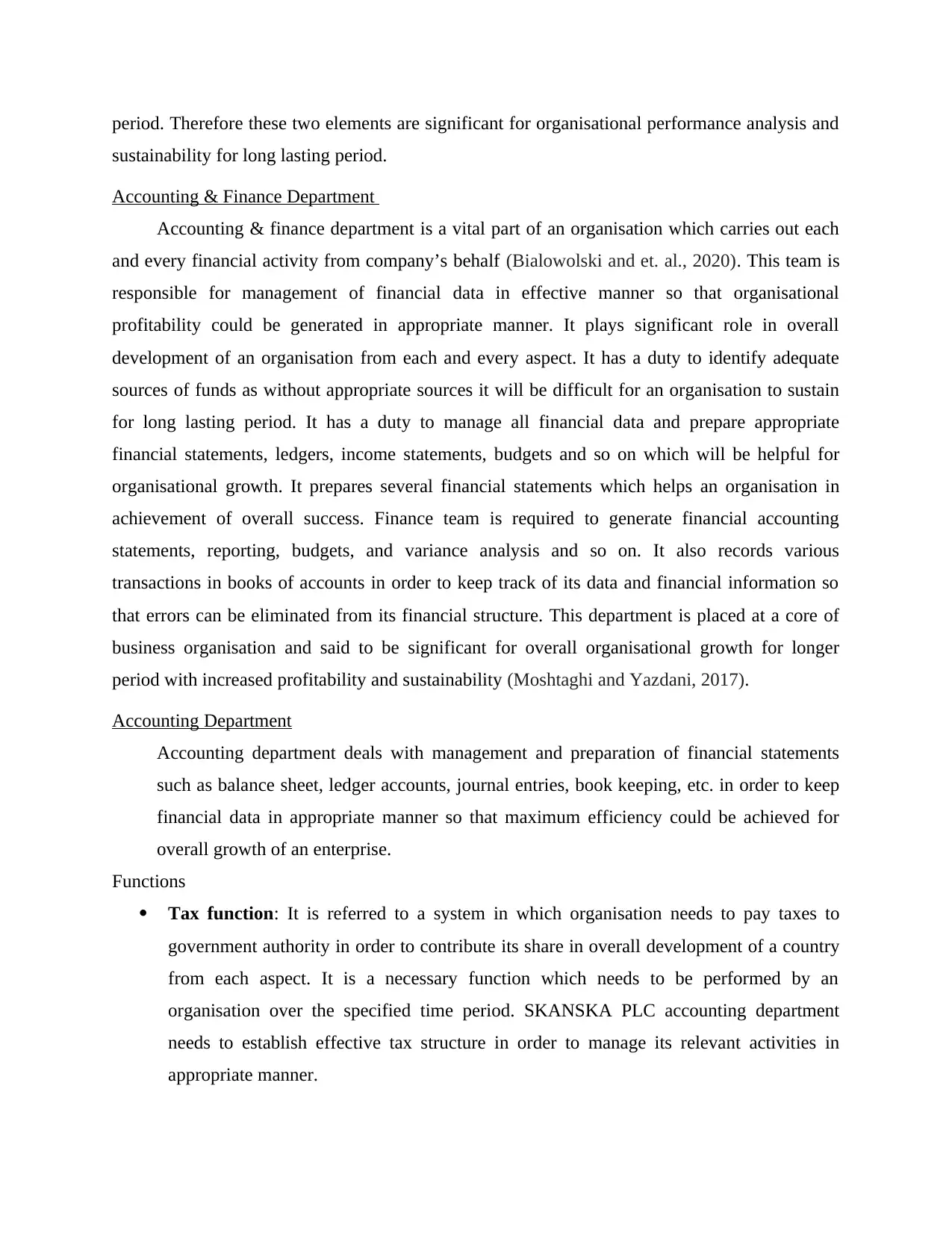
period. Therefore these two elements are significant for organisational performance analysis and
sustainability for long lasting period.
Accounting & Finance Department
Accounting & finance department is a vital part of an organisation which carries out each
and every financial activity from company’s behalf (Bialowolski and et. al., 2020). This team is
responsible for management of financial data in effective manner so that organisational
profitability could be generated in appropriate manner. It plays significant role in overall
development of an organisation from each and every aspect. It has a duty to identify adequate
sources of funds as without appropriate sources it will be difficult for an organisation to sustain
for long lasting period. It has a duty to manage all financial data and prepare appropriate
financial statements, ledgers, income statements, budgets and so on which will be helpful for
organisational growth. It prepares several financial statements which helps an organisation in
achievement of overall success. Finance team is required to generate financial accounting
statements, reporting, budgets, and variance analysis and so on. It also records various
transactions in books of accounts in order to keep track of its data and financial information so
that errors can be eliminated from its financial structure. This department is placed at a core of
business organisation and said to be significant for overall organisational growth for longer
period with increased profitability and sustainability (Moshtaghi and Yazdani, 2017).
Accounting Department
Accounting department deals with management and preparation of financial statements
such as balance sheet, ledger accounts, journal entries, book keeping, etc. in order to keep
financial data in appropriate manner so that maximum efficiency could be achieved for
overall growth of an enterprise.
Functions
Tax function: It is referred to a system in which organisation needs to pay taxes to
government authority in order to contribute its share in overall development of a country
from each aspect. It is a necessary function which needs to be performed by an
organisation over the specified time period. SKANSKA PLC accounting department
needs to establish effective tax structure in order to manage its relevant activities in
appropriate manner.
sustainability for long lasting period.
Accounting & Finance Department
Accounting & finance department is a vital part of an organisation which carries out each
and every financial activity from company’s behalf (Bialowolski and et. al., 2020). This team is
responsible for management of financial data in effective manner so that organisational
profitability could be generated in appropriate manner. It plays significant role in overall
development of an organisation from each and every aspect. It has a duty to identify adequate
sources of funds as without appropriate sources it will be difficult for an organisation to sustain
for long lasting period. It has a duty to manage all financial data and prepare appropriate
financial statements, ledgers, income statements, budgets and so on which will be helpful for
organisational growth. It prepares several financial statements which helps an organisation in
achievement of overall success. Finance team is required to generate financial accounting
statements, reporting, budgets, and variance analysis and so on. It also records various
transactions in books of accounts in order to keep track of its data and financial information so
that errors can be eliminated from its financial structure. This department is placed at a core of
business organisation and said to be significant for overall organisational growth for longer
period with increased profitability and sustainability (Moshtaghi and Yazdani, 2017).
Accounting Department
Accounting department deals with management and preparation of financial statements
such as balance sheet, ledger accounts, journal entries, book keeping, etc. in order to keep
financial data in appropriate manner so that maximum efficiency could be achieved for
overall growth of an enterprise.
Functions
Tax function: It is referred to a system in which organisation needs to pay taxes to
government authority in order to contribute its share in overall development of a country
from each aspect. It is a necessary function which needs to be performed by an
organisation over the specified time period. SKANSKA PLC accounting department
needs to establish effective tax structure in order to manage its relevant activities in
appropriate manner.
Paraphrase This Document
Need a fresh take? Get an instant paraphrase of this document with our AI Paraphraser
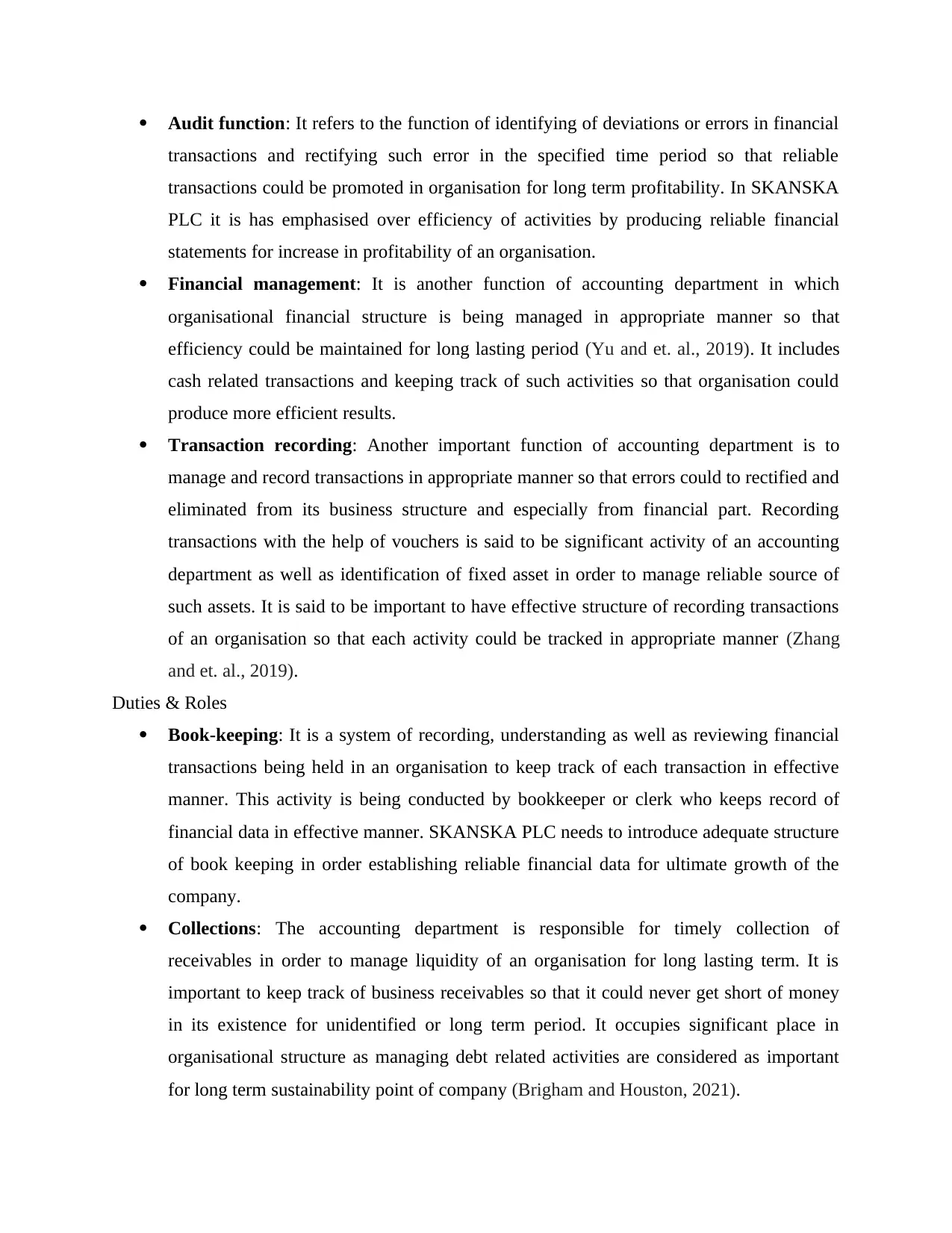
Audit function: It refers to the function of identifying of deviations or errors in financial
transactions and rectifying such error in the specified time period so that reliable
transactions could be promoted in organisation for long term profitability. In SKANSKA
PLC it is has emphasised over efficiency of activities by producing reliable financial
statements for increase in profitability of an organisation.
Financial management: It is another function of accounting department in which
organisational financial structure is being managed in appropriate manner so that
efficiency could be maintained for long lasting period (Yu and et. al., 2019). It includes
cash related transactions and keeping track of such activities so that organisation could
produce more efficient results.
Transaction recording: Another important function of accounting department is to
manage and record transactions in appropriate manner so that errors could to rectified and
eliminated from its business structure and especially from financial part. Recording
transactions with the help of vouchers is said to be significant activity of an accounting
department as well as identification of fixed asset in order to manage reliable source of
such assets. It is said to be important to have effective structure of recording transactions
of an organisation so that each activity could be tracked in appropriate manner (Zhang
and et. al., 2019).
Duties & Roles
Book-keeping: It is a system of recording, understanding as well as reviewing financial
transactions being held in an organisation to keep track of each transaction in effective
manner. This activity is being conducted by bookkeeper or clerk who keeps record of
financial data in effective manner. SKANSKA PLC needs to introduce adequate structure
of book keeping in order establishing reliable financial data for ultimate growth of the
company.
Collections: The accounting department is responsible for timely collection of
receivables in order to manage liquidity of an organisation for long lasting term. It is
important to keep track of business receivables so that it could never get short of money
in its existence for unidentified or long term period. It occupies significant place in
organisational structure as managing debt related activities are considered as important
for long term sustainability point of company (Brigham and Houston, 2021).
transactions and rectifying such error in the specified time period so that reliable
transactions could be promoted in organisation for long term profitability. In SKANSKA
PLC it is has emphasised over efficiency of activities by producing reliable financial
statements for increase in profitability of an organisation.
Financial management: It is another function of accounting department in which
organisational financial structure is being managed in appropriate manner so that
efficiency could be maintained for long lasting period (Yu and et. al., 2019). It includes
cash related transactions and keeping track of such activities so that organisation could
produce more efficient results.
Transaction recording: Another important function of accounting department is to
manage and record transactions in appropriate manner so that errors could to rectified and
eliminated from its business structure and especially from financial part. Recording
transactions with the help of vouchers is said to be significant activity of an accounting
department as well as identification of fixed asset in order to manage reliable source of
such assets. It is said to be important to have effective structure of recording transactions
of an organisation so that each activity could be tracked in appropriate manner (Zhang
and et. al., 2019).
Duties & Roles
Book-keeping: It is a system of recording, understanding as well as reviewing financial
transactions being held in an organisation to keep track of each transaction in effective
manner. This activity is being conducted by bookkeeper or clerk who keeps record of
financial data in effective manner. SKANSKA PLC needs to introduce adequate structure
of book keeping in order establishing reliable financial data for ultimate growth of the
company.
Collections: The accounting department is responsible for timely collection of
receivables in order to manage liquidity of an organisation for long lasting term. It is
important to keep track of business receivables so that it could never get short of money
in its existence for unidentified or long term period. It occupies significant place in
organisational structure as managing debt related activities are considered as important
for long term sustainability point of company (Brigham and Houston, 2021).
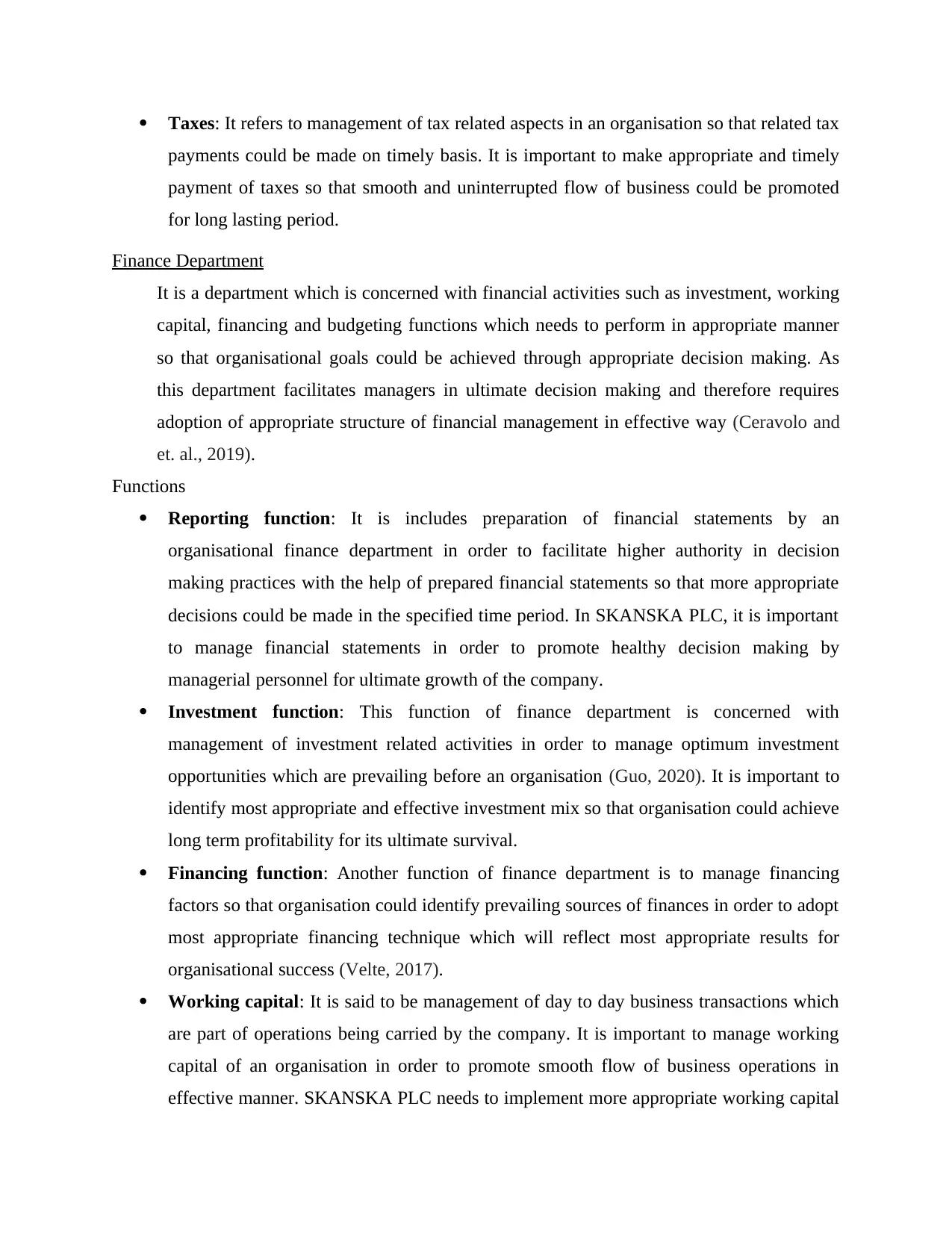
Taxes: It refers to management of tax related aspects in an organisation so that related tax
payments could be made on timely basis. It is important to make appropriate and timely
payment of taxes so that smooth and uninterrupted flow of business could be promoted
for long lasting period.
Finance Department
It is a department which is concerned with financial activities such as investment, working
capital, financing and budgeting functions which needs to perform in appropriate manner
so that organisational goals could be achieved through appropriate decision making. As
this department facilitates managers in ultimate decision making and therefore requires
adoption of appropriate structure of financial management in effective way (Ceravolo and
et. al., 2019).
Functions
Reporting function: It is includes preparation of financial statements by an
organisational finance department in order to facilitate higher authority in decision
making practices with the help of prepared financial statements so that more appropriate
decisions could be made in the specified time period. In SKANSKA PLC, it is important
to manage financial statements in order to promote healthy decision making by
managerial personnel for ultimate growth of the company.
Investment function: This function of finance department is concerned with
management of investment related activities in order to manage optimum investment
opportunities which are prevailing before an organisation (Guo, 2020). It is important to
identify most appropriate and effective investment mix so that organisation could achieve
long term profitability for its ultimate survival.
Financing function: Another function of finance department is to manage financing
factors so that organisation could identify prevailing sources of finances in order to adopt
most appropriate financing technique which will reflect most appropriate results for
organisational success (Velte, 2017).
Working capital: It is said to be management of day to day business transactions which
are part of operations being carried by the company. It is important to manage working
capital of an organisation in order to promote smooth flow of business operations in
effective manner. SKANSKA PLC needs to implement more appropriate working capital
payments could be made on timely basis. It is important to make appropriate and timely
payment of taxes so that smooth and uninterrupted flow of business could be promoted
for long lasting period.
Finance Department
It is a department which is concerned with financial activities such as investment, working
capital, financing and budgeting functions which needs to perform in appropriate manner
so that organisational goals could be achieved through appropriate decision making. As
this department facilitates managers in ultimate decision making and therefore requires
adoption of appropriate structure of financial management in effective way (Ceravolo and
et. al., 2019).
Functions
Reporting function: It is includes preparation of financial statements by an
organisational finance department in order to facilitate higher authority in decision
making practices with the help of prepared financial statements so that more appropriate
decisions could be made in the specified time period. In SKANSKA PLC, it is important
to manage financial statements in order to promote healthy decision making by
managerial personnel for ultimate growth of the company.
Investment function: This function of finance department is concerned with
management of investment related activities in order to manage optimum investment
opportunities which are prevailing before an organisation (Guo, 2020). It is important to
identify most appropriate and effective investment mix so that organisation could achieve
long term profitability for its ultimate survival.
Financing function: Another function of finance department is to manage financing
factors so that organisation could identify prevailing sources of finances in order to adopt
most appropriate financing technique which will reflect most appropriate results for
organisational success (Velte, 2017).
Working capital: It is said to be management of day to day business transactions which
are part of operations being carried by the company. It is important to manage working
capital of an organisation in order to promote smooth flow of business operations in
effective manner. SKANSKA PLC needs to implement more appropriate working capital
⊘ This is a preview!⊘
Do you want full access?
Subscribe today to unlock all pages.

Trusted by 1+ million students worldwide
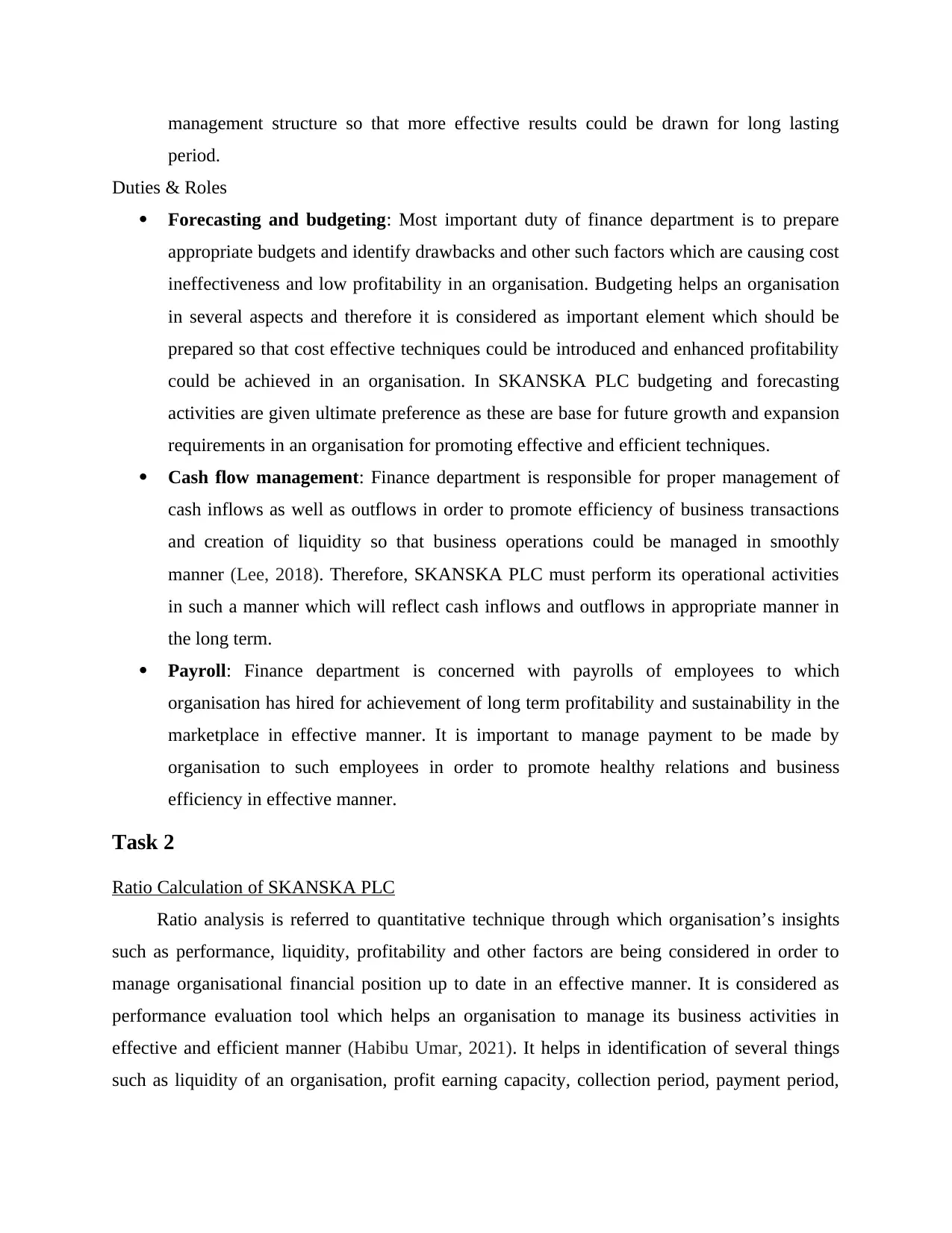
management structure so that more effective results could be drawn for long lasting
period.
Duties & Roles
Forecasting and budgeting: Most important duty of finance department is to prepare
appropriate budgets and identify drawbacks and other such factors which are causing cost
ineffectiveness and low profitability in an organisation. Budgeting helps an organisation
in several aspects and therefore it is considered as important element which should be
prepared so that cost effective techniques could be introduced and enhanced profitability
could be achieved in an organisation. In SKANSKA PLC budgeting and forecasting
activities are given ultimate preference as these are base for future growth and expansion
requirements in an organisation for promoting effective and efficient techniques.
Cash flow management: Finance department is responsible for proper management of
cash inflows as well as outflows in order to promote efficiency of business transactions
and creation of liquidity so that business operations could be managed in smoothly
manner (Lee, 2018). Therefore, SKANSKA PLC must perform its operational activities
in such a manner which will reflect cash inflows and outflows in appropriate manner in
the long term.
Payroll: Finance department is concerned with payrolls of employees to which
organisation has hired for achievement of long term profitability and sustainability in the
marketplace in effective manner. It is important to manage payment to be made by
organisation to such employees in order to promote healthy relations and business
efficiency in effective manner.
Task 2
Ratio Calculation of SKANSKA PLC
Ratio analysis is referred to quantitative technique through which organisation’s insights
such as performance, liquidity, profitability and other factors are being considered in order to
manage organisational financial position up to date in an effective manner. It is considered as
performance evaluation tool which helps an organisation to manage its business activities in
effective and efficient manner (Habibu Umar, 2021). It helps in identification of several things
such as liquidity of an organisation, profit earning capacity, collection period, payment period,
period.
Duties & Roles
Forecasting and budgeting: Most important duty of finance department is to prepare
appropriate budgets and identify drawbacks and other such factors which are causing cost
ineffectiveness and low profitability in an organisation. Budgeting helps an organisation
in several aspects and therefore it is considered as important element which should be
prepared so that cost effective techniques could be introduced and enhanced profitability
could be achieved in an organisation. In SKANSKA PLC budgeting and forecasting
activities are given ultimate preference as these are base for future growth and expansion
requirements in an organisation for promoting effective and efficient techniques.
Cash flow management: Finance department is responsible for proper management of
cash inflows as well as outflows in order to promote efficiency of business transactions
and creation of liquidity so that business operations could be managed in smoothly
manner (Lee, 2018). Therefore, SKANSKA PLC must perform its operational activities
in such a manner which will reflect cash inflows and outflows in appropriate manner in
the long term.
Payroll: Finance department is concerned with payrolls of employees to which
organisation has hired for achievement of long term profitability and sustainability in the
marketplace in effective manner. It is important to manage payment to be made by
organisation to such employees in order to promote healthy relations and business
efficiency in effective manner.
Task 2
Ratio Calculation of SKANSKA PLC
Ratio analysis is referred to quantitative technique through which organisation’s insights
such as performance, liquidity, profitability and other factors are being considered in order to
manage organisational financial position up to date in an effective manner. It is considered as
performance evaluation tool which helps an organisation to manage its business activities in
effective and efficient manner (Habibu Umar, 2021). It helps in identification of several things
such as liquidity of an organisation, profit earning capacity, collection period, payment period,
Paraphrase This Document
Need a fresh take? Get an instant paraphrase of this document with our AI Paraphraser
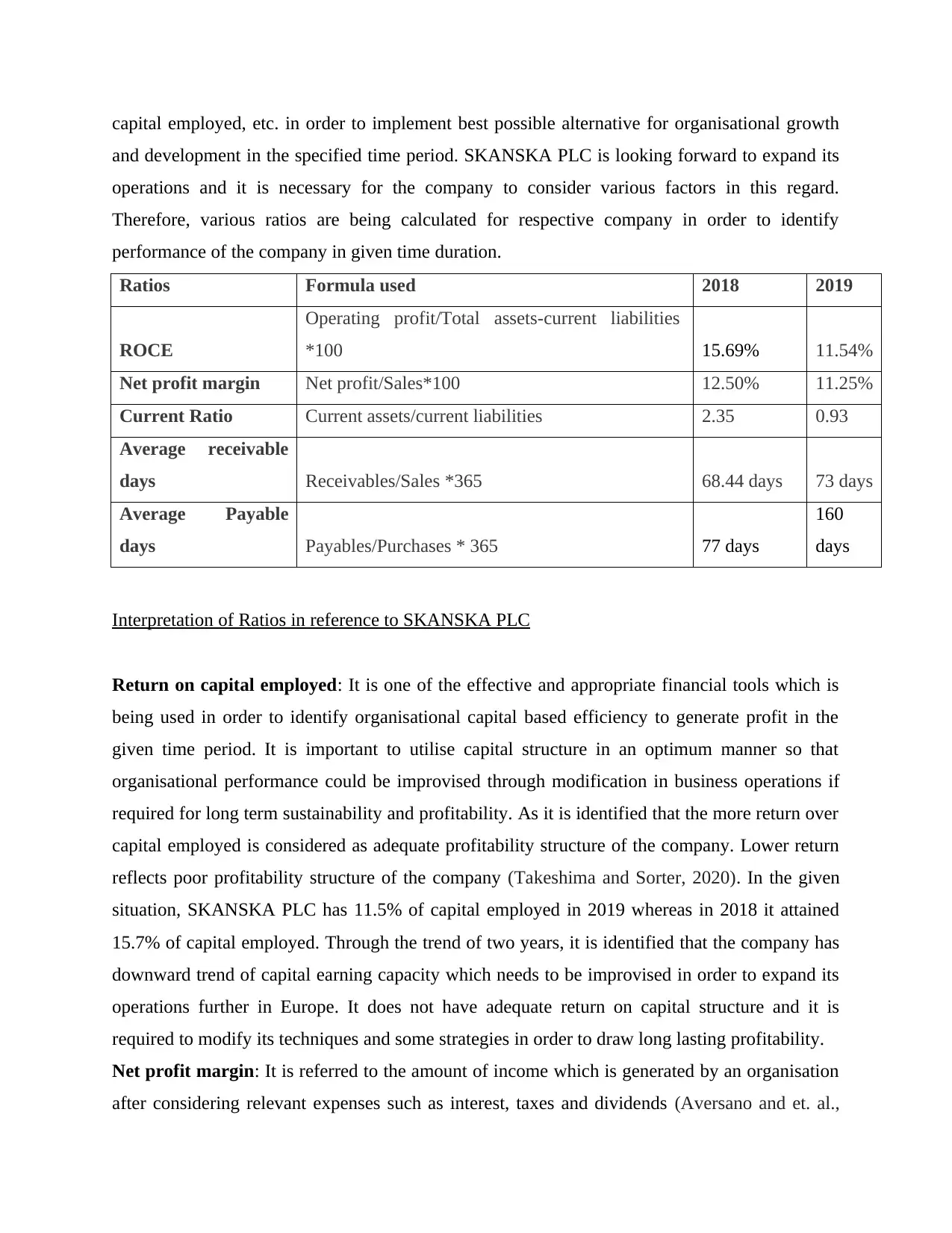
capital employed, etc. in order to implement best possible alternative for organisational growth
and development in the specified time period. SKANSKA PLC is looking forward to expand its
operations and it is necessary for the company to consider various factors in this regard.
Therefore, various ratios are being calculated for respective company in order to identify
performance of the company in given time duration.
Ratios Formula used 2018 2019
ROCE
Operating profit/Total assets-current liabilities
*100 15.69% 11.54%
Net profit margin Net profit/Sales*100 12.50% 11.25%
Current Ratio Current assets/current liabilities 2.35 0.93
Average receivable
days Receivables/Sales *365 68.44 days 73 days
Average Payable
days Payables/Purchases * 365 77 days
160
days
Interpretation of Ratios in reference to SKANSKA PLC
Return on capital employed: It is one of the effective and appropriate financial tools which is
being used in order to identify organisational capital based efficiency to generate profit in the
given time period. It is important to utilise capital structure in an optimum manner so that
organisational performance could be improvised through modification in business operations if
required for long term sustainability and profitability. As it is identified that the more return over
capital employed is considered as adequate profitability structure of the company. Lower return
reflects poor profitability structure of the company (Takeshima and Sorter, 2020). In the given
situation, SKANSKA PLC has 11.5% of capital employed in 2019 whereas in 2018 it attained
15.7% of capital employed. Through the trend of two years, it is identified that the company has
downward trend of capital earning capacity which needs to be improvised in order to expand its
operations further in Europe. It does not have adequate return on capital structure and it is
required to modify its techniques and some strategies in order to draw long lasting profitability.
Net profit margin: It is referred to the amount of income which is generated by an organisation
after considering relevant expenses such as interest, taxes and dividends (Aversano and et. al.,
and development in the specified time period. SKANSKA PLC is looking forward to expand its
operations and it is necessary for the company to consider various factors in this regard.
Therefore, various ratios are being calculated for respective company in order to identify
performance of the company in given time duration.
Ratios Formula used 2018 2019
ROCE
Operating profit/Total assets-current liabilities
*100 15.69% 11.54%
Net profit margin Net profit/Sales*100 12.50% 11.25%
Current Ratio Current assets/current liabilities 2.35 0.93
Average receivable
days Receivables/Sales *365 68.44 days 73 days
Average Payable
days Payables/Purchases * 365 77 days
160
days
Interpretation of Ratios in reference to SKANSKA PLC
Return on capital employed: It is one of the effective and appropriate financial tools which is
being used in order to identify organisational capital based efficiency to generate profit in the
given time period. It is important to utilise capital structure in an optimum manner so that
organisational performance could be improvised through modification in business operations if
required for long term sustainability and profitability. As it is identified that the more return over
capital employed is considered as adequate profitability structure of the company. Lower return
reflects poor profitability structure of the company (Takeshima and Sorter, 2020). In the given
situation, SKANSKA PLC has 11.5% of capital employed in 2019 whereas in 2018 it attained
15.7% of capital employed. Through the trend of two years, it is identified that the company has
downward trend of capital earning capacity which needs to be improvised in order to expand its
operations further in Europe. It does not have adequate return on capital structure and it is
required to modify its techniques and some strategies in order to draw long lasting profitability.
Net profit margin: It is referred to the amount of income which is generated by an organisation
after considering relevant expenses such as interest, taxes and dividends (Aversano and et. al.,
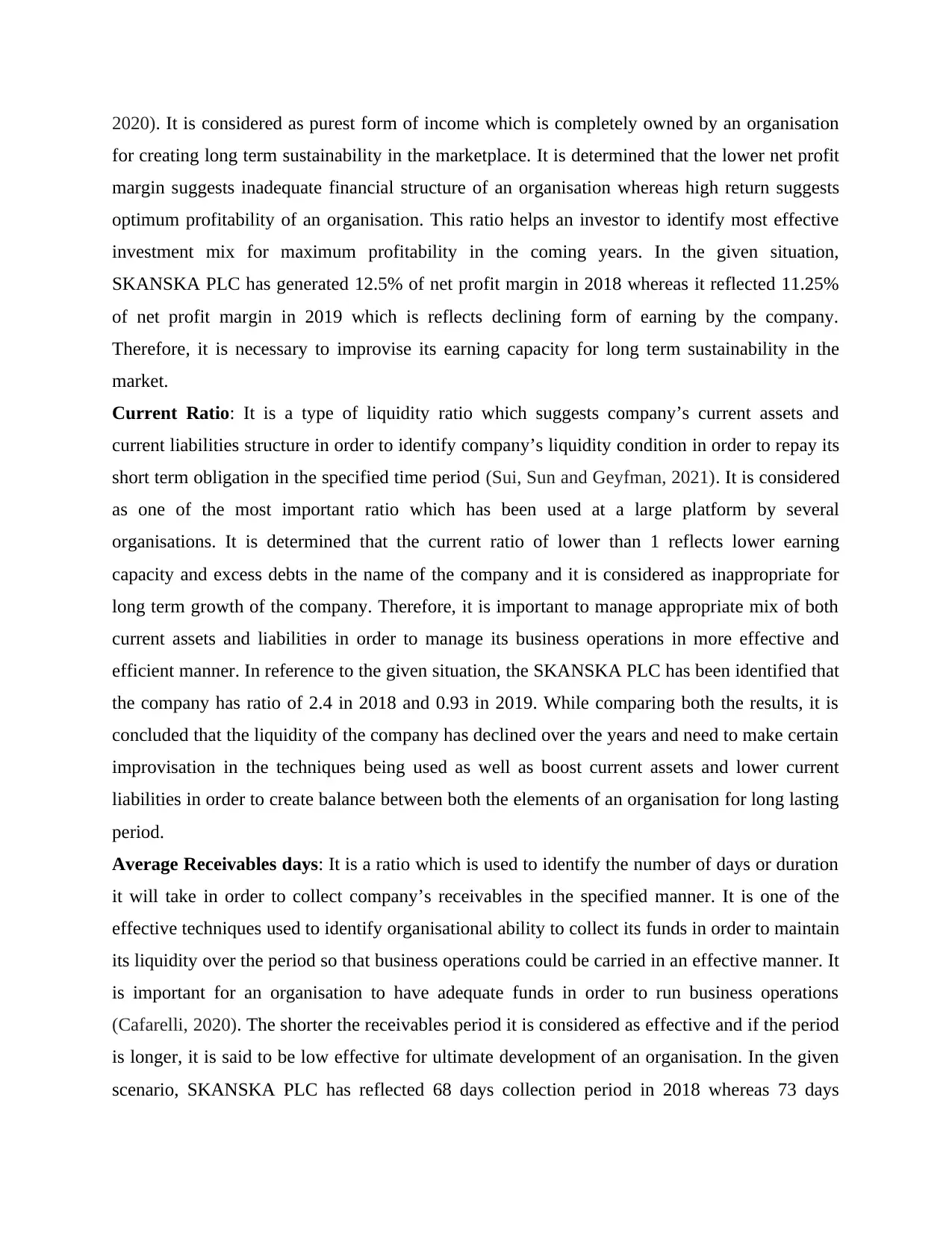
2020). It is considered as purest form of income which is completely owned by an organisation
for creating long term sustainability in the marketplace. It is determined that the lower net profit
margin suggests inadequate financial structure of an organisation whereas high return suggests
optimum profitability of an organisation. This ratio helps an investor to identify most effective
investment mix for maximum profitability in the coming years. In the given situation,
SKANSKA PLC has generated 12.5% of net profit margin in 2018 whereas it reflected 11.25%
of net profit margin in 2019 which is reflects declining form of earning by the company.
Therefore, it is necessary to improvise its earning capacity for long term sustainability in the
market.
Current Ratio: It is a type of liquidity ratio which suggests company’s current assets and
current liabilities structure in order to identify company’s liquidity condition in order to repay its
short term obligation in the specified time period (Sui, Sun and Geyfman, 2021). It is considered
as one of the most important ratio which has been used at a large platform by several
organisations. It is determined that the current ratio of lower than 1 reflects lower earning
capacity and excess debts in the name of the company and it is considered as inappropriate for
long term growth of the company. Therefore, it is important to manage appropriate mix of both
current assets and liabilities in order to manage its business operations in more effective and
efficient manner. In reference to the given situation, the SKANSKA PLC has been identified that
the company has ratio of 2.4 in 2018 and 0.93 in 2019. While comparing both the results, it is
concluded that the liquidity of the company has declined over the years and need to make certain
improvisation in the techniques being used as well as boost current assets and lower current
liabilities in order to create balance between both the elements of an organisation for long lasting
period.
Average Receivables days: It is a ratio which is used to identify the number of days or duration
it will take in order to collect company’s receivables in the specified manner. It is one of the
effective techniques used to identify organisational ability to collect its funds in order to maintain
its liquidity over the period so that business operations could be carried in an effective manner. It
is important for an organisation to have adequate funds in order to run business operations
(Cafarelli, 2020). The shorter the receivables period it is considered as effective and if the period
is longer, it is said to be low effective for ultimate development of an organisation. In the given
scenario, SKANSKA PLC has reflected 68 days collection period in 2018 whereas 73 days
for creating long term sustainability in the marketplace. It is determined that the lower net profit
margin suggests inadequate financial structure of an organisation whereas high return suggests
optimum profitability of an organisation. This ratio helps an investor to identify most effective
investment mix for maximum profitability in the coming years. In the given situation,
SKANSKA PLC has generated 12.5% of net profit margin in 2018 whereas it reflected 11.25%
of net profit margin in 2019 which is reflects declining form of earning by the company.
Therefore, it is necessary to improvise its earning capacity for long term sustainability in the
market.
Current Ratio: It is a type of liquidity ratio which suggests company’s current assets and
current liabilities structure in order to identify company’s liquidity condition in order to repay its
short term obligation in the specified time period (Sui, Sun and Geyfman, 2021). It is considered
as one of the most important ratio which has been used at a large platform by several
organisations. It is determined that the current ratio of lower than 1 reflects lower earning
capacity and excess debts in the name of the company and it is considered as inappropriate for
long term growth of the company. Therefore, it is important to manage appropriate mix of both
current assets and liabilities in order to manage its business operations in more effective and
efficient manner. In reference to the given situation, the SKANSKA PLC has been identified that
the company has ratio of 2.4 in 2018 and 0.93 in 2019. While comparing both the results, it is
concluded that the liquidity of the company has declined over the years and need to make certain
improvisation in the techniques being used as well as boost current assets and lower current
liabilities in order to create balance between both the elements of an organisation for long lasting
period.
Average Receivables days: It is a ratio which is used to identify the number of days or duration
it will take in order to collect company’s receivables in the specified manner. It is one of the
effective techniques used to identify organisational ability to collect its funds in order to maintain
its liquidity over the period so that business operations could be carried in an effective manner. It
is important for an organisation to have adequate funds in order to run business operations
(Cafarelli, 2020). The shorter the receivables period it is considered as effective and if the period
is longer, it is said to be low effective for ultimate development of an organisation. In the given
scenario, SKANSKA PLC has reflected 68 days collection period in 2018 whereas 73 days
⊘ This is a preview!⊘
Do you want full access?
Subscribe today to unlock all pages.

Trusted by 1+ million students worldwide
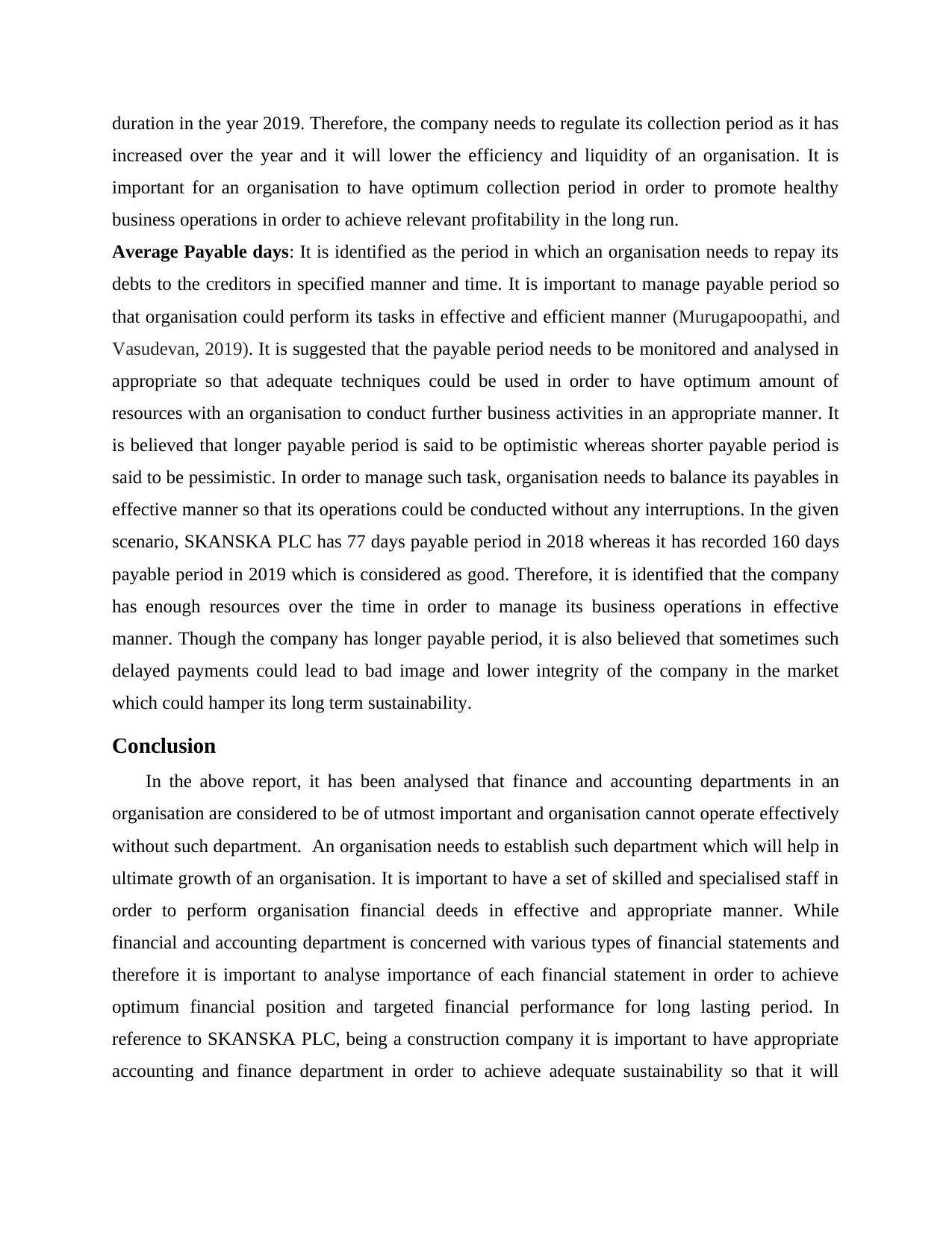
duration in the year 2019. Therefore, the company needs to regulate its collection period as it has
increased over the year and it will lower the efficiency and liquidity of an organisation. It is
important for an organisation to have optimum collection period in order to promote healthy
business operations in order to achieve relevant profitability in the long run.
Average Payable days: It is identified as the period in which an organisation needs to repay its
debts to the creditors in specified manner and time. It is important to manage payable period so
that organisation could perform its tasks in effective and efficient manner (Murugapoopathi, and
Vasudevan, 2019). It is suggested that the payable period needs to be monitored and analysed in
appropriate so that adequate techniques could be used in order to have optimum amount of
resources with an organisation to conduct further business activities in an appropriate manner. It
is believed that longer payable period is said to be optimistic whereas shorter payable period is
said to be pessimistic. In order to manage such task, organisation needs to balance its payables in
effective manner so that its operations could be conducted without any interruptions. In the given
scenario, SKANSKA PLC has 77 days payable period in 2018 whereas it has recorded 160 days
payable period in 2019 which is considered as good. Therefore, it is identified that the company
has enough resources over the time in order to manage its business operations in effective
manner. Though the company has longer payable period, it is also believed that sometimes such
delayed payments could lead to bad image and lower integrity of the company in the market
which could hamper its long term sustainability.
Conclusion
In the above report, it has been analysed that finance and accounting departments in an
organisation are considered to be of utmost important and organisation cannot operate effectively
without such department. An organisation needs to establish such department which will help in
ultimate growth of an organisation. It is important to have a set of skilled and specialised staff in
order to perform organisation financial deeds in effective and appropriate manner. While
financial and accounting department is concerned with various types of financial statements and
therefore it is important to analyse importance of each financial statement in order to achieve
optimum financial position and targeted financial performance for long lasting period. In
reference to SKANSKA PLC, being a construction company it is important to have appropriate
accounting and finance department in order to achieve adequate sustainability so that it will
increased over the year and it will lower the efficiency and liquidity of an organisation. It is
important for an organisation to have optimum collection period in order to promote healthy
business operations in order to achieve relevant profitability in the long run.
Average Payable days: It is identified as the period in which an organisation needs to repay its
debts to the creditors in specified manner and time. It is important to manage payable period so
that organisation could perform its tasks in effective and efficient manner (Murugapoopathi, and
Vasudevan, 2019). It is suggested that the payable period needs to be monitored and analysed in
appropriate so that adequate techniques could be used in order to have optimum amount of
resources with an organisation to conduct further business activities in an appropriate manner. It
is believed that longer payable period is said to be optimistic whereas shorter payable period is
said to be pessimistic. In order to manage such task, organisation needs to balance its payables in
effective manner so that its operations could be conducted without any interruptions. In the given
scenario, SKANSKA PLC has 77 days payable period in 2018 whereas it has recorded 160 days
payable period in 2019 which is considered as good. Therefore, it is identified that the company
has enough resources over the time in order to manage its business operations in effective
manner. Though the company has longer payable period, it is also believed that sometimes such
delayed payments could lead to bad image and lower integrity of the company in the market
which could hamper its long term sustainability.
Conclusion
In the above report, it has been analysed that finance and accounting departments in an
organisation are considered to be of utmost important and organisation cannot operate effectively
without such department. An organisation needs to establish such department which will help in
ultimate growth of an organisation. It is important to have a set of skilled and specialised staff in
order to perform organisation financial deeds in effective and appropriate manner. While
financial and accounting department is concerned with various types of financial statements and
therefore it is important to analyse importance of each financial statement in order to achieve
optimum financial position and targeted financial performance for long lasting period. In
reference to SKANSKA PLC, being a construction company it is important to have appropriate
accounting and finance department in order to achieve adequate sustainability so that it will
Paraphrase This Document
Need a fresh take? Get an instant paraphrase of this document with our AI Paraphraser

become easier for the company to expand its operation further in other locations for achieving
worldwide recognition and adequate market position for its ultimate success.
worldwide recognition and adequate market position for its ultimate success.
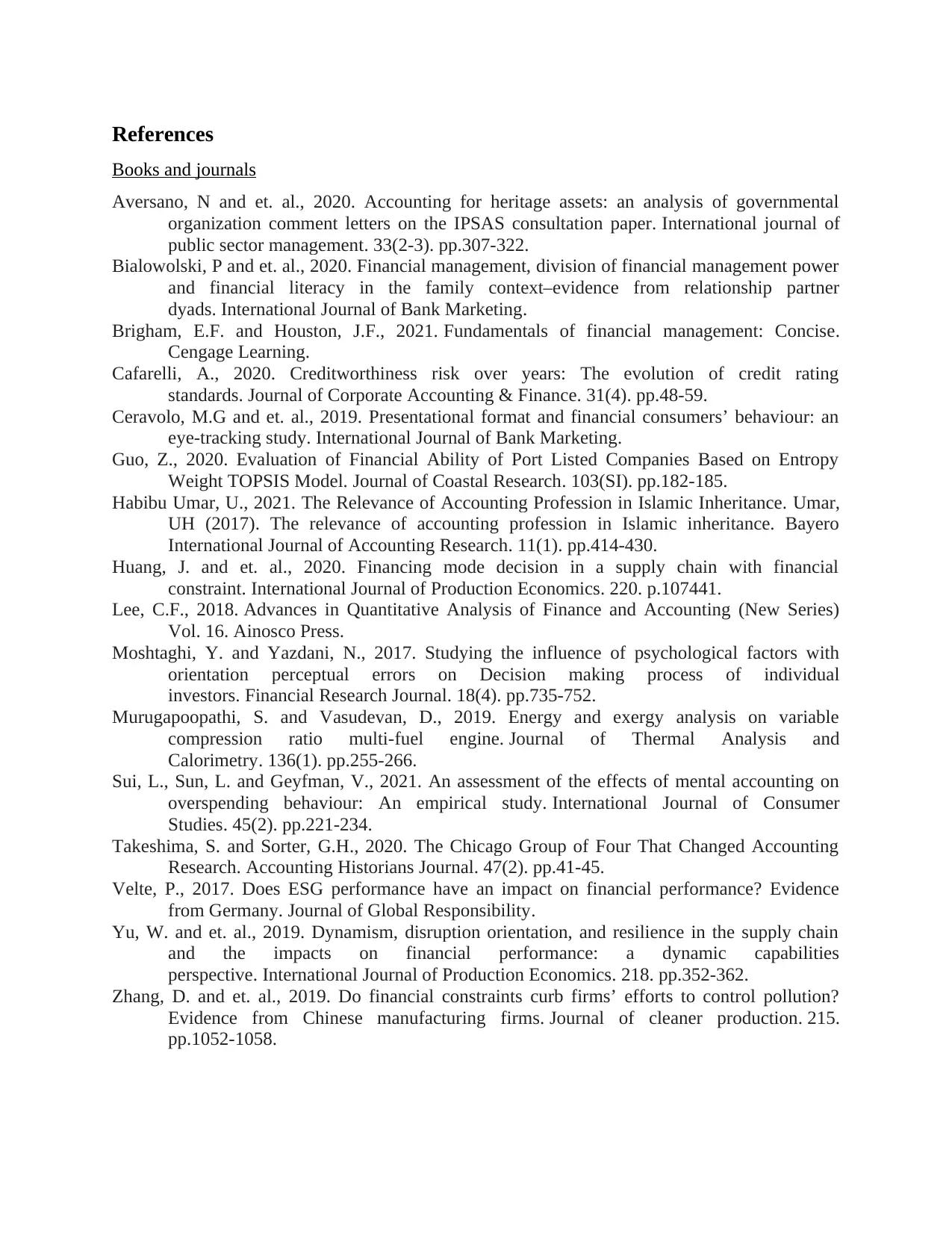
References
Books and journals
Aversano, N and et. al., 2020. Accounting for heritage assets: an analysis of governmental
organization comment letters on the IPSAS consultation paper. International journal of
public sector management. 33(2-3). pp.307-322.
Bialowolski, P and et. al., 2020. Financial management, division of financial management power
and financial literacy in the family context–evidence from relationship partner
dyads. International Journal of Bank Marketing.
Brigham, E.F. and Houston, J.F., 2021. Fundamentals of financial management: Concise.
Cengage Learning.
Cafarelli, A., 2020. Creditworthiness risk over years: The evolution of credit rating
standards. Journal of Corporate Accounting & Finance. 31(4). pp.48-59.
Ceravolo, M.G and et. al., 2019. Presentational format and financial consumers’ behaviour: an
eye-tracking study. International Journal of Bank Marketing.
Guo, Z., 2020. Evaluation of Financial Ability of Port Listed Companies Based on Entropy
Weight TOPSIS Model. Journal of Coastal Research. 103(SI). pp.182-185.
Habibu Umar, U., 2021. The Relevance of Accounting Profession in Islamic Inheritance. Umar,
UH (2017). The relevance of accounting profession in Islamic inheritance. Bayero
International Journal of Accounting Research. 11(1). pp.414-430.
Huang, J. and et. al., 2020. Financing mode decision in a supply chain with financial
constraint. International Journal of Production Economics. 220. p.107441.
Lee, C.F., 2018. Advances in Quantitative Analysis of Finance and Accounting (New Series)
Vol. 16. Ainosco Press.
Moshtaghi, Y. and Yazdani, N., 2017. Studying the influence of psychological factors with
orientation perceptual errors on Decision making process of individual
investors. Financial Research Journal. 18(4). pp.735-752.
Murugapoopathi, S. and Vasudevan, D., 2019. Energy and exergy analysis on variable
compression ratio multi-fuel engine. Journal of Thermal Analysis and
Calorimetry. 136(1). pp.255-266.
Sui, L., Sun, L. and Geyfman, V., 2021. An assessment of the effects of mental accounting on
overspending behaviour: An empirical study. International Journal of Consumer
Studies. 45(2). pp.221-234.
Takeshima, S. and Sorter, G.H., 2020. The Chicago Group of Four That Changed Accounting
Research. Accounting Historians Journal. 47(2). pp.41-45.
Velte, P., 2017. Does ESG performance have an impact on financial performance? Evidence
from Germany. Journal of Global Responsibility.
Yu, W. and et. al., 2019. Dynamism, disruption orientation, and resilience in the supply chain
and the impacts on financial performance: a dynamic capabilities
perspective. International Journal of Production Economics. 218. pp.352-362.
Zhang, D. and et. al., 2019. Do financial constraints curb firms’ efforts to control pollution?
Evidence from Chinese manufacturing firms. Journal of cleaner production. 215.
pp.1052-1058.
Books and journals
Aversano, N and et. al., 2020. Accounting for heritage assets: an analysis of governmental
organization comment letters on the IPSAS consultation paper. International journal of
public sector management. 33(2-3). pp.307-322.
Bialowolski, P and et. al., 2020. Financial management, division of financial management power
and financial literacy in the family context–evidence from relationship partner
dyads. International Journal of Bank Marketing.
Brigham, E.F. and Houston, J.F., 2021. Fundamentals of financial management: Concise.
Cengage Learning.
Cafarelli, A., 2020. Creditworthiness risk over years: The evolution of credit rating
standards. Journal of Corporate Accounting & Finance. 31(4). pp.48-59.
Ceravolo, M.G and et. al., 2019. Presentational format and financial consumers’ behaviour: an
eye-tracking study. International Journal of Bank Marketing.
Guo, Z., 2020. Evaluation of Financial Ability of Port Listed Companies Based on Entropy
Weight TOPSIS Model. Journal of Coastal Research. 103(SI). pp.182-185.
Habibu Umar, U., 2021. The Relevance of Accounting Profession in Islamic Inheritance. Umar,
UH (2017). The relevance of accounting profession in Islamic inheritance. Bayero
International Journal of Accounting Research. 11(1). pp.414-430.
Huang, J. and et. al., 2020. Financing mode decision in a supply chain with financial
constraint. International Journal of Production Economics. 220. p.107441.
Lee, C.F., 2018. Advances in Quantitative Analysis of Finance and Accounting (New Series)
Vol. 16. Ainosco Press.
Moshtaghi, Y. and Yazdani, N., 2017. Studying the influence of psychological factors with
orientation perceptual errors on Decision making process of individual
investors. Financial Research Journal. 18(4). pp.735-752.
Murugapoopathi, S. and Vasudevan, D., 2019. Energy and exergy analysis on variable
compression ratio multi-fuel engine. Journal of Thermal Analysis and
Calorimetry. 136(1). pp.255-266.
Sui, L., Sun, L. and Geyfman, V., 2021. An assessment of the effects of mental accounting on
overspending behaviour: An empirical study. International Journal of Consumer
Studies. 45(2). pp.221-234.
Takeshima, S. and Sorter, G.H., 2020. The Chicago Group of Four That Changed Accounting
Research. Accounting Historians Journal. 47(2). pp.41-45.
Velte, P., 2017. Does ESG performance have an impact on financial performance? Evidence
from Germany. Journal of Global Responsibility.
Yu, W. and et. al., 2019. Dynamism, disruption orientation, and resilience in the supply chain
and the impacts on financial performance: a dynamic capabilities
perspective. International Journal of Production Economics. 218. pp.352-362.
Zhang, D. and et. al., 2019. Do financial constraints curb firms’ efforts to control pollution?
Evidence from Chinese manufacturing firms. Journal of cleaner production. 215.
pp.1052-1058.
⊘ This is a preview!⊘
Do you want full access?
Subscribe today to unlock all pages.

Trusted by 1+ million students worldwide
1 out of 12
Related Documents
Your All-in-One AI-Powered Toolkit for Academic Success.
+13062052269
info@desklib.com
Available 24*7 on WhatsApp / Email
![[object Object]](/_next/static/media/star-bottom.7253800d.svg)
Unlock your academic potential
Copyright © 2020–2025 A2Z Services. All Rights Reserved. Developed and managed by ZUCOL.





